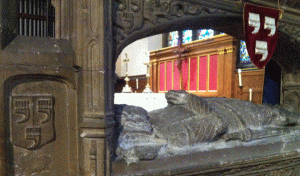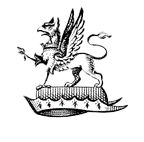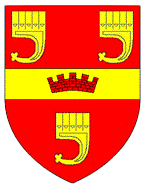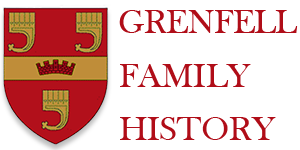The Grenfell Coat of Arms
The short answer is Gules, three organ rests, or  : the heraldic ‘blazon’ or formal description. ‘Gules’ is Red, and ‘Or’ is Gold, usually depicted as yellow. In English the Arms are ‘Three gold organ rests on a red background’.
: the heraldic ‘blazon’ or formal description. ‘Gules’ is Red, and ‘Or’ is Gold, usually depicted as yellow. In English the Arms are ‘Three gold organ rests on a red background’.
The longer answer is less straightforward.
First, the ‘organ rest’ is a curious object. It would be easy to see it as a set of organ pipes, but it has been described in a variety of different ways: a Lance Rest, or simply Rest, a Sufflue (French: souffler: for blowing air – into an organ), a Rudder (apparently inverted), a Clavicord and a Clarion. It could even be a Syrinx, an old musical instrument, the biblical Jubal’s Organ. The website https://www.heraldica.org/topics/clarion.htm gives a good account of these uncertainties.
 Second, the photograph shows the tomb in St Mary’s church, Bideford, in Devon of Sir Thomas Grenville who died in 1513. The arms appear several times and are blazoned Gules, three clarions, or – the same as the arms above, but with a clarion rather than an organ rest. The seventh generation in the male line from Sir Thomas was Sir John Grenville, who was created Earl of Bath and Viscount Granville of Lansdown.
Second, the photograph shows the tomb in St Mary’s church, Bideford, in Devon of Sir Thomas Grenville who died in 1513. The arms appear several times and are blazoned Gules, three clarions, or – the same as the arms above, but with a clarion rather than an organ rest. The seventh generation in the male line from Sir Thomas was Sir John Grenville, who was created Earl of Bath and Viscount Granville of Lansdown.
In his book Family Origins published in 1930, Dr Horace Round writes that the Granville coat of arms was later taken by the modern Grenfell family, which he describes as ‘founded by Pascoe Grenfell of Marazion, died 1810’. A coat of arms consists of the shield, as above, with the crest above it, and supporters.
The Grenfell Crest
The Grenfell crest is  On a chapeau gules, turned up ermine, a griffin passant, or. A chapeau is usually described in English as a ‘cap of maintenance’. The golden griffin is ‘passant’ or walking to the left with one foot raised. Supporters are either side of the shield and hold it upright, at least symbolically. They are specific to the person concerned and usually depict some aspect of their life.
On a chapeau gules, turned up ermine, a griffin passant, or. A chapeau is usually described in English as a ‘cap of maintenance’. The golden griffin is ‘passant’ or walking to the left with one foot raised. Supporters are either side of the shield and hold it upright, at least symbolically. They are specific to the person concerned and usually depict some aspect of their life.
The motto is optional. The Grenfell motto is ‘Loyal devoir’ or loyal duty.
The Baronial Arms
When Field Marshall Sir Francis Grenfell was raised to the peerage in 1902 a ‘difference’ was added to the shield – a red mural crown on a gold horizontal bar. It is blazoned Gules, on a fess between three organ rests or, a mural crown of the first. William Grenfell and Edward Grenfell were also ennobled, as Barons Desborough (1905) and St Just (1935). They all have the same shield, but their supporters are:
 Grenfell: an Egyptian cavalry soldier and an Egyptian infantry soldier
Grenfell: an Egyptian cavalry soldier and an Egyptian infantry soldier
Desborough: a golden griffin on each side holding a red flag with a gold organ rest.
St Just: a gate porter of the Bank of England and a sailor of the merchant marine.
Another difference is in the crest, with a sprig of laurel in the griffin’s beak.
According to the College of Heralds “if three men were all descended in the direct male line from a man who had been granted arms, they would all bear the same arms. A brief search in the College records for the grants of arms made to the three Grenfell peers suggests that all three grants were confirmations of existing arms in this manner.” The closest common ancestor of the three barons was Pascoe Grenfell MP (1761 – 1837) son of Pascoe Grenfell of Marazion (1729 – 1810). Sir Wilfred Grenfell also had the ‘Grenfell shield’. Dr Round was probably right to mention Pascoe Grenfell of Marazion, the common ancestor of all four men.
Frank Grenfell, Oxford, College of Heralds, London. Family Origins, Blazons, own work (Public Domain), from Wikimedia Commons. November 2018.

